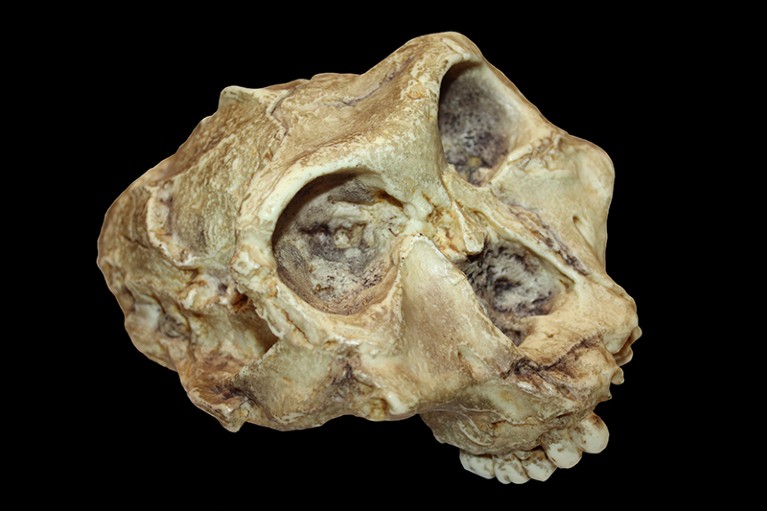Hello Nature readers, would you like to get this Briefing in your inbox free every day? Sign up here.

A Paranthropus robustus skull.Credit: Sabena Jane Blackbird/Alamy
The oldest genetic data of a relative of humans have been extracted from two-million-year-old teeth of the ancient hominin species Paranthropus robustus. The genetic data come from protein sequences rather than DNA, which tends to be less resilient. The researchers identified the sex of the hominins that the teeth belonged to, and confirmed that Homo sapiens, Neanderthals and Denisovans are all more closely related to one another than they are to the Paranthropus. The jury is still out on whether ancient proteins will help bring consensus to the picture of hominin evolution, which is currently built largely from the shapes of bones.
Reference: bioRxiv preprint (not peer reviewed)
Researchers turned a radio telescope towards 68 of SpaceX’s Starlink broadband satellites and found that 47 of them were emitting radio waves at frequencies in a protected band allocated to radio astronomy. Gadgets on the ground that emit these frequencies are regulated by strict rules — but they don’t apply in space. There are now more than 4,300 satellites in the Starlink system, and astronomers are concerned that huge ‘megaconstallations’ of the objects could one day cause problems for observation.
Reference: Astronomy & Astrophysics paper
We seem to be able to ‘hear’ total silence rather than just infer its presence. In experiments, the way that people responded to silence-based auditory and visual illusions was the same as how they responded to sound-based ones. This suggests our brains use similar mechanisms to process both sounds and the lack thereof. You can try out the silence-based illusions for yourself.
Features & opinion
‘An irreversible cessation of all functions of the entire brain, including the brainstem’ is how brain death has been legally defined in the United States since 1981. It’s language that many clinicians view as imprecise, highlighted by cases such as that of 13-year-old Jahi McMath who was declared brain dead in one state while remaining legally alive in another. A group of neurologists, physicians, lawyers and bioethicists is now attempting to harmonize state laws surrounding the determination of death. Some observers hope for relevant changes, for example to clarify that only certain brain areas are relevant to recovery. Others fear that ideological differences will muddy the definition further, with potentially negative consequences for intensive-care units and people awaiting organ transplants.
“I wanted to do great science, but I also wanted to do what was best for my family,” writes biomedical researcher Alex Soto-Avellaneda about his choice to pursue postdoctoral work at an independent research institute. “For someone else, being outside a larger system might be a deal-breaker,” he notes. “I feel supported, wanted and empowered to pursue a career path that I’d thought previously was unattainable.”
The experience of being ‘on the same wavelength’ as another person is real. When people interact socially — by chatting, learning together or concocting a collaborative story — their brain waves synchronize: neurons in corresponding locations in the different brains fire at the same time. Although much about the phenomenon remains mysterious, scientists suspect that it is more than the result of two people seeing or hearing the same thing. “When we’re talking to each other, we kind of create a single überbrain that isn’t reducible to the sum of its parts,” says neuroscientist Thalia Wheatley. This could explain why social isolation is so harmful to physical and mental health.
Scientific American | 16 min read
Infographic of the week

Figure 1 | DNA wireframes that fold in a similar way to origami paper. a, In an analogy to origami paper with predefined folding lines, nanoscale meshes of geometrically arranged ‘wires’, each made from a bundle of two DNA helices (2HB), were constructed that enable folding along each wire edge. Scale bars, 10 mm (left) and 10 nm (right). b, Four original-size sheets of DNA-wireframe paper (A, B, C and D) were assembled to make a larger sheet. Attachments between the original sheets are shown in green, blue, red and yellow. Short DNA overhangs (pink and orange) positioned along the DNA wires enable folding along orthogonal wires to achieve different shapes; a diamond shape is shown here. HD (diagonal-half) and QD (diagonal-quarter) foldings were used for different quadrants. Folding was reversible, and DNA-wireframe sheets were designed to fold and unfold in response to different environmental stimuli (not shown). Scale bars, 50 nm.
Origami — the art of making various shapes from a single piece of paper — has been realized at the nanoscale using DNA. In this example, DNA ‘paper’ is folded into a diamond shape, driven by strands that connect and disconnect short DNA overhangs (shown in pink and orange).
Nature Research Briefing | 6 min read (Nature paywall) or read the full Nature paper (free-to-read link)







More News
Author Correction: Stepwise activation of a metabotropic glutamate receptor – Nature
Changing rainforest to plantations shifts tropical food webs
Streamlined skull helps foxes take a nosedive